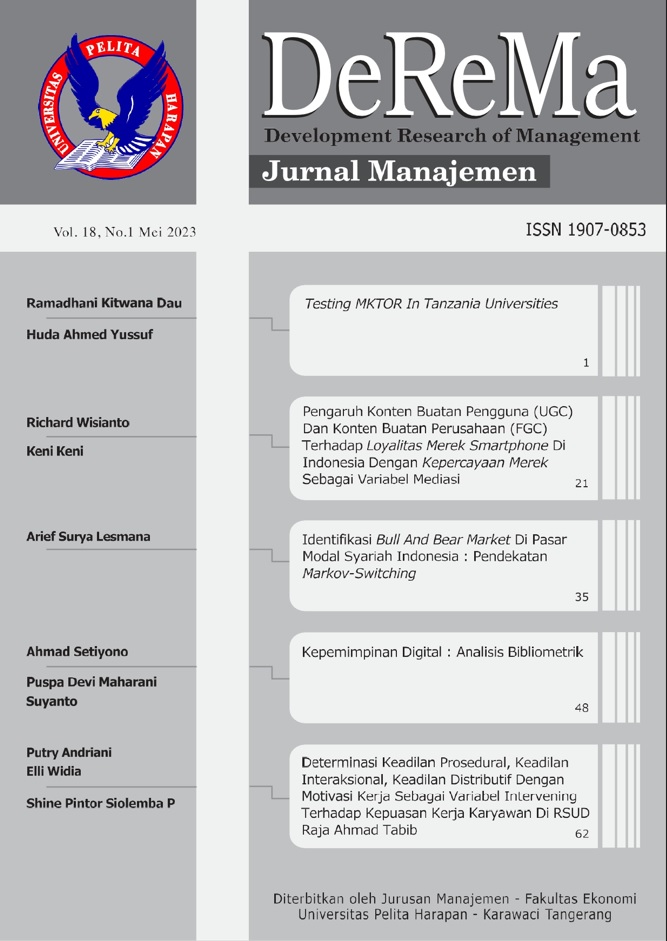KEPEMIMPINAN DIGITAL: ANALISIS BIBLIOMETRIK [DIGITAL LEADERSHIP: BIBLIOMETRIC ANALYSIS]
##semicolon##
https://doi.org/10.19166/derema.v18i1.6231##semicolon##
digital leadership##common.commaListSeparator## bibliometric analysis##common.commaListSeparator## kepemimpinan digital##common.commaListSeparator## analisis bibliometrik##common.commaListSeparator## VOSViewer##common.commaListSeparator## Scopus초록
The purpose of this study is to provide a literature review with an extensive bibliometric analysis of digital leadership developments so far, the main streams, which channels are most influential, and research network models in digital leadership studies. Search and collect articles using the Scopus Database with the keyword "Digital leadership". The search results get 1298 articles. This bibliometric analysis uses VOSViewer software. The clustering process is assisted by the VOSViewer software by matching the words that appear frequently in each group. Each of these groups represents an area of digital leadership research. The eight clusters generated through the VOSViewer software provide an overview and research flow on digital leadership. Finally, researchers and practitioners need to pay attention to trends and research areas in digital leadership to enhance digital leadership development.
Abstrak dalam Bahasa Indonesia. Tujuan dari penelitian ini adalah untuk memberikan tinjauan literatur dengan analisis bibliometrik yang luas tentang kepemimpinan digital perkembangannya sejauh ini, aliran utama, saluran mana yang paling berpengaruh dan model jejaring penelitian dalam kajian kepemimpinan digital. Pencarian dan pengumpulan artikel dengan menggunakan Database Scopus dengan kata kunci “Kepemimpinan digital”. Hasil pencarian mendapatkan 1298 artikel. Analisis bibliometrik ini menggunakan perangkat lunak VOSViewer. Proses clustering dibantu oleh software VOSViewer dengan cara mencocokkan kata-kata yang sering muncul pada setiap kelompok. Masing-masing kelompok ini menujukkan area penelitian kepemimpinan digital. Delapan klaster yang dihasilkan melalui perangkat lunak VOSViewer memberikan gambaran umum dan aliran penelitian tentang kepemimpinan digital. Akhirnya peneliti dan praktisi perlu memperhatikan tren dan bidang penelitian dalam kepemimpinan digital untuk meningkatkan pengembangan kepemimpinan digital.
##submission.citations##
Afza, R., Siregar, D.I., & Zaki, H. (2022). Analisis Pengaruh Kepemimpinan Transformasional dan Perilaku Kerja Inovatif Terhadap Kinerja Karyawan. DeReMa (Development of Research Management): Jurnal Manajemen, 17(1), 118-130. http://dx.doi.org/10.19166/derema.v17i1.4170
Antonopoulou H., Halkiopoulos C., Barlou O., & Beligiannis, G. (2019). Transition from educational leadership to e-leadership: A data analysis report from TEI of western Greece. International Journal of Learning, Teaching and Educational Research, 18(9), 238-255. https://doi.org/10.26803/ijlter.18.9.13
Annisa, A. (2021). Sejarah Revolusi Industri dari 1.0 sampai 4.0. Artikel Mahasiswa Sistem Telekomunikasi. https://doi.org/10.13140/RG.2.2.20215.24488
Chuang, K. Y., & Ho, Y. S. (2014). A bibliometric analysis on top-cited articles in pain research. Pain Medicine, 15(5), 732-744. https://doi.org/10.1111/pme.12308
Cobo, M. J., López-Herrera, A. G., Herrera-Viedma, E., & Herrera, F. (2011). Science Mapping Software Tools: Review, Analysis, and Cooperative Study Among Tools. Journal of the American Society for Information Science and Technology, 62(7), 1382-1402. https://doi.org/10.1002/asi.21525
Colbert, A.E., Yee, N., & George, G. (2016). The Digital Workforce and the Workplace of the Future. Academy of Management Journal, 59(1). 731-739. http://dx.doi.org/10.5465/amj.2016.4003
Diamante T., L. M. (2002). Expansive leadership in the age of digital technology. Expansive Leadership in the Age of Digital Technology, 21(6), 404-416. https://doi.org/10.1108/02621710210430597
Dougan C., Philips S.-A., & Hughes D., G. K. (2021). Compassionate leadership during COVID-19: An ABC approach to the introduction of new medical graduates as Foundation interim Year 1s (FiY1s). BMJ Leader, 5(3), 199-202. https://doi.org/10.1136/leader-2020-000323
Furinto, A., & Wasono, L. W. (2018). The effect of digital leadership and innovation management for incumbent telecommunication company in the digital disruptive era. International Journal of Engineering and Technology, 7(2.29), https://doi.org/10.14419/ijet.v7i2.29.13142
Harrison, J. S., Bosse, D. A., & Phillips, R. A. (2010). Managing for stakeholders, stakeholder utility functions, and competitive advantage. Strategic Management Journal, 31(1), 58-74. https://doi.org/10.1002/smj.801
Hensellek, S. (2020). Kepemimpinan digital: A framework for successful leadership in the digital age. Journal of Media Management and Entrepreneurship, 2(1), 55-69. https://doi.org/10.4018/JMME.2020010104
Karakose, T., Kocabas, I., Yirci, R., Papadakis, S., Ozdemir, T. Y., & Demirkol, M. (2022). The Development and Evolution of Kepemimpinan digital: A Bibliometric Mapping Approach-Based Study. Sustainability (Switzerland), 14(23). https://doi.org/10.3390/su142316171
Klus, M. F., & Müller, J. (2021). The digital leader: What one needs to master today’s organisational challenges. Journal of Business Economics, 91(8), 1189-1223. Springer Berlin Heidelberg. https://doi.org/10.1007/s11573-021-01040-1
Li, W., Liu, K., Belitski, M., & Ghobadian A., O'Regan, N. (2016). e-Leadership through strategic alignment: An empirical study of small- and medium-sized enterprises in the digital age. Journal of Information Technology, 31(2). https://doi.org/10.1057/jit.2016.10
Liu, X. (2013). Full-text citation analysis: A new metod to enhance scholary networks. Journal of the American Society for Information Science and Technology, 64(9), 1852-1863. https://doi.org/10.1002/asi.22883
Maltz, E., & Chiappetta, V. (2002). Maximizing value in the digital world. MIT Sloan Management Review, 43(3), 77-84.
Mihardjo, L. W. W., Sasmoko, S., Alamsjah, F., & Djap, E. (2019). Kepemimpinan digital impacts on developing dynamic capability and strategic alliance based on market orientation. Polish Journal of Management Studies, 19(2), 285-297. https://doi.org/10.17512/pjms.2019.19.2.24
Peng, B. (2021). Kepemimpinan digital: State governance in the era of digital technology. Culture of Science, 5(4), 210-225. https://doi.org/10.1177/2096608321989835
Pulley, M.L, & Sessa, V. I. (2001). E-leadership: Tackling complex challenges. Industrial and Commercial Training, 33(6), 225-230. https://doi.org/10.1108/00197850110405379
Putra, I. K. M., Pasek, I. K., & Arsawan, I. W. E. (2022). Digital Transformation and Agile Leadership : Bibliometrics Analysis and Future Avenue. Journal of International Conference Proceedings, 5(4), 96-110. https://doi.org/10.32535/jicp.v5i4.1926
Quddus, A., Nugroho, B. S., Hakim, L., Ritaudin, M. S., Nurhasanah, E., Suarsa, A., Karyanto, U. B., Tanjung, R., Hendar, Pratama, V. Y., Awali, H., Mufid, A., Purwanto, A., Fahlevi, M., & Sudargini, Y. (2020) Effect of Ecological, Servant dan Digital Leadership Style Influence University Performance? Evidence from Indonesian Universities. Systematic Reviews in Pharmacy, 11(10), 408-417. doi:10.31838/srp.2020.10.64
Reis, J., Amorim, M., Melao, N., & Matos, P. (2016). Digital Transformation : A Literature Review and Guidelines for Future Digital Transformation : A Literature Review and Guidelines for Future Research. 10th European Conference on Information Systems Management. Academic Conferences and Publishing Limited, 1(March), 20-28. https://doi.org/10.1007/978-3-319-77703-0
Rudito, P., & Sinaga, M. (2017). Digital Mastery: Membangun kepemimpinan digital untuk memenangkan era disrupsi. Gramedia Pustaka Utama.
Smaje, K., & Zemmel, R. (2022). Digital transformation on the CEO agenda. McKinsey Digital.
Sow, M., & Aborbie, S. (2018). Impact of Leadership on Digital Transformation. Business and Economic Research, 8(3), 139-148. https://doi.org/10.5296/ber.v8i3.13368
Van Eck, N. J., & Waltman, L. (2010). Software survey: VOSViewer, a computer program for bibliometric mapping. Scientometrics, 84(2), 523-538. https://doi.org/10.1007/s11192-009-0146-3
Verameta, A., Listiani, I., & Sijabat, R. (2021). Pengaruh Kepemimpinan Transformasional Dan Pengembangan Karir Terhadap Kinerja Dengan Mediasi Kepuasan Kerja Pada Aparatur Sipil Negara Kementerian Perdagangan Republik Indonesia. DeReMa (Development of Research Management): Jurnal Manajemen 16(1), 33-54. http://dx.doi.org/10.19166/derema.v16i1.2948
Verhoef, P., Broekhuizen, T. L. J., Bart, Y., Bhattacharya, A., Dong, J. Q., Febian, N., & Haenlein, M. (2021). Digital transformation: A multidisciplinary reflection and research agenda. Journal of Business Research, 122(13), 889-901. https://doi.org/10.1016/j.jbusres.2019.09.022
Zeiner R., L. W. (2016). E-health - Kepemimpinan digital. Part 2: The pacemakers of today for the playmakers of tomorrow/The digital transformation changes management, culture, organization and work [E-Health - Kepemimpinan digital: Teil 2: Die Schrittmacher von heute für die Spielma. Pharmazeutische Industrie, 78(6), 807-816.
Zhu, P. (2015). Digital Master: Debunk the Myths of Enterprise Digital Maturity. Lulu Press, Inc.
Zulu, S. L., & Khosrowshahi, F. (2021). A taxonomy of kepemimpinan digital in the construction industri. Construction Management and Economics, 39(7), 565-578. https://doi.org/10.1080/01446193.2021.1930080
Zupic, I., & ÄŒater, T. (2015). Bibliometric Methods in Management and Organization. Organizational Research Methods, 18(3), 429-472. https://doi.org/10.1177/1094428114562629
##submission.downloads##
출판됨
권
세션
##submission.license##
Authors who publish with this journal agree to the following terms:
1) Authors retain copyright and grant the journal right of first publication with the work simultaneously licensed under a Creative Commons Attribution License (CC-BY-SA 4.0) that allows others to share the work with an acknowledgement of the work's authorship and initial publication in this journal.
2) Authors are able to enter into separate, additional contractual arrangements for the non-exclusive distribution of the journal's published version of the work (e.g., post it to an institutional repository or publish it in a book), with an acknowledgement of its initial publication in this journal.
3) Authors are permitted and encouraged to post their work online (e.g., in institutional repositories or on their website). The final published PDF should be used and bibliographic details that credit the publication in this journal should be included.





